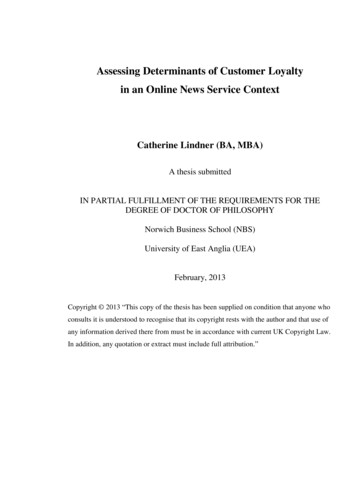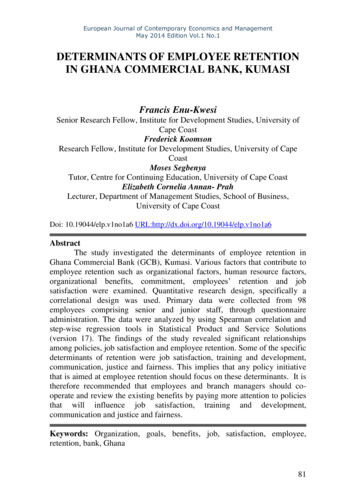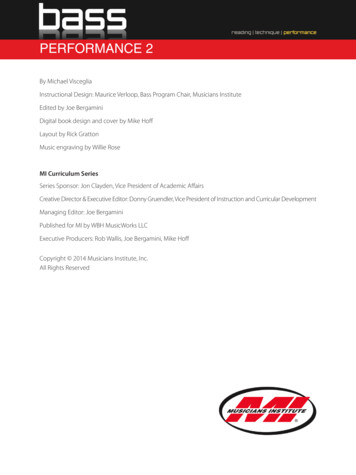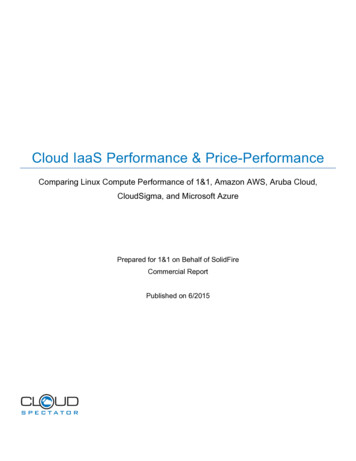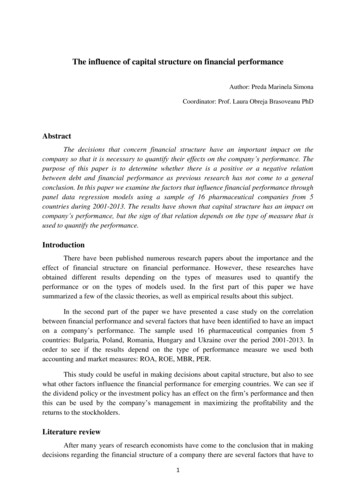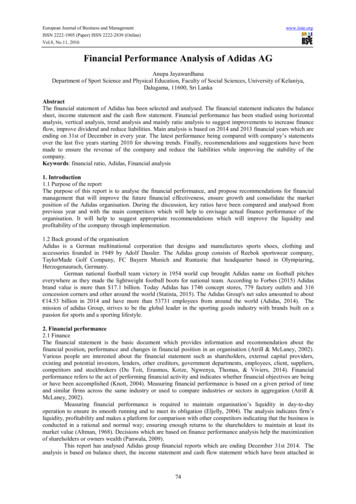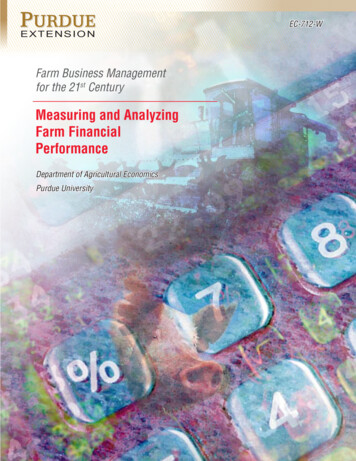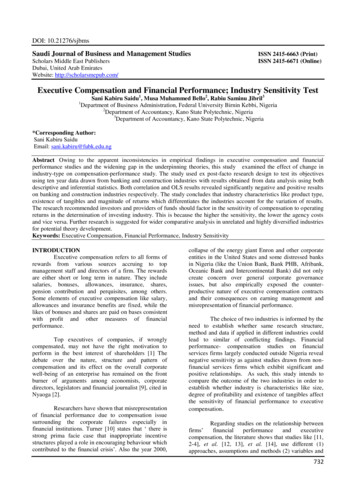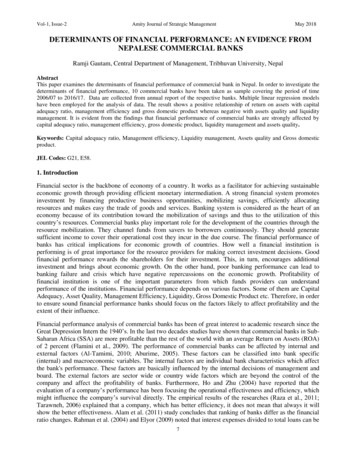
Transcription
Vol-1, Issue-2Amity Journal of Strategic ManagementMay 2018DETERMINANTS OF FINANCIAL PERFORMANCE: AN EVIDENCE FROMNEPALESE COMMERCIAL BANKSRamji Gautam, Central Department of Management, Tribhuvan University, NepalAbstractThis paper examines the determinants of financial performance of commercial bank in Nepal. In order to investigate thedeterminants of financial performance, 10 commercial banks have been taken as sample covering the period of time2006/07 to 2016/17. Data are collected from annual report of the respective banks. Multiple linear regression modelshave been employed for the analysis of data. The result shows a positive relationship of return on assets with capitaladequacy ratio, management efficiency and gross domestic product whereas negative with assets quality and liquiditymanagement. It is evident from the findings that financial performance of commercial banks are strongly affected bycapital adequacy ratio, management efficiency, gross domestic product, liquidity management and assets quality.Keywords: Capital adequacy ratio, Management efficiency, Liquidity management, Assets quality and Gross domesticproduct.JEL Codes: G21, E58.1. IntroductionFinancial sector is the backbone of economy of a country. It works as a facilitator for achieving sustainableeconomic growth through providing efficient monetary intermediation. A strong financial system promotesinvestment by financing productive business opportunities, mobilizing savings, efficiently allocatingresources and makes easy the trade of goods and services. Banking system is considered as the heart of aneconomy because of its contribution toward the mobilization of savings and thus to the utilization of thiscountry’s resources. Commercial banks play important role for the development of the countries through theresource mobilization. They channel funds from savers to borrowers continuously. They should generatesufficient income to cover their operational cost they incur in the due course. The financial performance ofbanks has critical implications for economic growth of countries. How well a financial institution isperforming is of great importance for the resource providers for making correct investment decisions. Goodfinancial performance rewards the shareholders for their investment. This, in turn, encourages additionalinvestment and brings about economic growth. On the other hand, poor banking performance can lead tobanking failure and crisis which have negative repercussions on the economic growth. Profitability offinancial institution is one of the important parameters from which funds providers can understandperformance of the institutions. Financial performance depends on various factors. Some of them are CapitalAdequacy, Asset Quality, Management Efficiency, Liquidity, Gross Domestic Product etc. Therefore, in orderto ensure sound financial performance banks should focus on the factors likely to affect profitability and theextent of their influence.Financial performance analysis of commercial banks has been of great interest to academic research since theGreat Depression Intern the 1940’s. In the last two decades studies have shown that commercial banks in SubSaharan Africa (SSA) are more profitable than the rest of the world with an average Return on Assets (ROA)of 2 percent (Flamini et al., 2009). The performance of commercial banks can be affected by internal andexternal factors (Al-Tamimi, 2010; Aburime, 2005). These factors can be classified into bank specific(internal) and macroeconomic variables. The internal factors are individual bank characteristics which affectthe bank's performance. These factors are basically influenced by the internal decisions of management andboard. The external factors are sector wide or country wide factors which are beyond the control of thecompany and affect the profitability of banks. Furthermore, Ho and Zhu (2004) have reported that theevaluation of a company’s performance has been focusing the operational effectiveness and efficiency, whichmight influence the company’s survival directly. The empirical results of the researches (Raza et al., 2011;Tarawneh, 2006) explained that a company, which has better efficiency, it does not mean that always it willshow the better effectiveness. Alam et al. (2011) study concludes that ranking of banks differ as the financialratio changes. Rahman et al. (2004) and Elyor (2009) noted that interest expenses divided to total loans can be7
measured as the bank management quality. Ability to support the present and future operations of a bankdepends on the quality of its earnings and profitability profile (Share et al., 2011). Tarawneh (2006) foundthat the banks having high total capital, deposits, credits, or total assets does not always means that hashealthier profitability and performance. The operational efficiency and asset management, in adding to thebank size, positively influenced the financial performance of these banks. Gopinathan (2009) has presentedthat the financial ratios analysis can spot better investment options for investors as the ratio analysis measuresvarious aspects of the performance and analyzes fundamentals of a company or an institution. Banking hasbecome an important feature, which renders service to the people in financial matters, and its magnitude ofaction is extending day by day. It is a major financial institutional system in Nepal, which accounted for morethan 70% (Poudel, 2005) of the total assets of all the financial institutions. NRB uses return on total assets asan indicator of profitability of a commercial bank.The main purpose of this study is to analyze the financial performance of commercial banks in Nepal.Specially, it examines the performance of commercial banks through capital adequacy ratio, liquidity ratio,management efficiency, asset quality and gross domestic product.2. Literature ReviewSeveral research works have been conducted on financial soundness and performance of banking sectorthroughout the world by using variety of approaches. The study of McKinnon (1973) and Levine (1997)havereported that the efficacy of a financial system to reduce information and transaction costs plays an importantrole in determining the rate of savings, investment decisions, technological innovations and hence the rate ofeconomic growth. Hassan & Bashir (2002) conducted a study covering Islamic banks worldwide during 19942001 to identify the determinants of Islamic banks’ profitability. The study concluded that high capital andloan-to-asset ratios lead to higher profitability and implicit and explicit taxes affect the bank performancemeasures negatively while favorable macroeconomic conditions impact performance measures positively. Astudy was carried out by Kosmidou et al. (2005) to examine the relationship between performance of UKbanks and credit risk measured in terms of loan loss reserves. Findings indicate that loan loss reserves arepositive on net interest margin, but have negative insignificant effect on bank profits.Sufian & Habibullah (2009) examined the performance of 37 Bangladeshi commercial banks between 1997and 2004. The study revealed that bank loans intensity, credit risk, and cost have positive and significantimpacts on bank performance whereas bank size exhibits a negative impact on return on average equity(ROAE).Furthermore, the study also examined the impact of macroeconomic indicators and concluded thatthe variables have no significant impact on bank profitability except inflation which has a negativerelationship with Bangladeshi banks profitability. Chowdhury & Ahmed (2009) concluded that the prospectof private commercial banks in Bangladesh is very bright as they have observed a stable growth of branches,employees, deposits, loans and advances, net income, earnings per share during the period of 2002-2006.For assessing the financial performance of Palestinian commercial banks, Alkhatib & Harsheh (2012) tookfive Palestinian commercial banks listed on Palestine Securities Exchange covering the period 2005-2010. Byemploying the multiple regression, the study found statistically insignificant impact of bank size, credit risk,operational efficiency and asset management on financial performance of Palestinian commercial banks.Kolapo & Ayeni (2012) carried out an empirical investigation into the quantitative effect of credit risk on theperformance of commercial banks in Nigeria over the period of 11 years (2000-2010). The results showed thatan increase in non-performing loan and loan loss provision reduce profitability (ROA) of banks while anincrease in total loan and advances lead to increase profitability. Choong et al. (2012) studied the Performanceof Islamic Commercial Banks of Malaysia and analyze their performance. The empirical results indicated thatcredit risk, liquidity rate and concentration of Islamic commercial banking are the most contributing factors inthe performance of local Islamic commercial banks in Malaysia.Fantal et al (2013) assessed the relationship between selected internal and external corporate governancemechanisms, and bank performance as measured by return on equity (ROE) and return on assets (ROA)covering the period 2005 to 2011. The study indicated that board size and existence of audit committee in the8
board had statistically significant negative effect on bank performance whereas bank size and capitaladequacy ratio had statistically significant positive effect on bank performance. Ameur & Mhiri (2013)studied 10 commercial Tunisian banks during the period 1998 to 2011 period to identify factors explainingTunisian bank performance. This study incorporated bank-specific as well as industry-specific andmacroeconomic factors affecting bank performance. The findings suggested that the bank capitalization aswell as the best managerial efficiency have positive and significant impact on the bank performance. Thestudy also concluded that industry-specific factor such as the concentration has a negative and a significantimpact on performance. Moreover, macroeconomic indicators do not have a significant impact on bankperformance.In the context of Nepal, Shrestha, (2015) found that that non-performing loan to total loan, capital adequacyratio, GDP and inflation are the major determinants of bank profitability. Hakuduwal (2014) concluded thatthere is positive significant impact of total assets, total deposits and loan and advance on profitabilityindicator ROA in Nepalese finance companies.Review of previous literatures reveal that number of studies has been done in the context of financialperformance. However, in the context of Nepal no sufficient studies have been found. Hence, an attempt hasbeen made to fill this research gap. Therefore, the objective of this study is to identify the determinants of thefinancial performance of commercial banks operating in Nepal.3. Research MethodologyA sample of 10 commercial banks from banking industry has been taken for the purpose of the study. In thisstudy, secondary data has been used. All required secondary data for this study has been taken from annualreport of concerned banks and web site of Nepal Rastra Bank. The data covers a ten- year period starting from2006/07 to 2016/17. Multiple linear regression model has been employed for the analysis of data.3.1. Model SpecificationThe following model has been used to study the determinants of financial performance of commercial banks.According to this model, financial performance is a function of capital adequacy ratio, managementefficiency, asset quality, liquidity ratio and gross domestic product (GDP). Hence, the modes take thefollowing form:ROA 𝛽o 𝛽1 CA 𝛽2 AQ 𝛽3ME 𝛽4LM 𝛽5GDP EWhere,ROA Performance of Bank i at time t as expressed by return on assetsCA Capital Adequacy of bankAQ Asset Quality of bankME Management Efficiency of BankLM Liquidity Ratio of BankGDP Gross Domestic Product𝛽0 Constante Error𝛽1 ,𝛽2,𝛽3, 𝛽4&𝛽5 are parameters of the independent variables.Variable definedThe explained variable in this study is financial performance which is defined as ratio of net income to totalassets that is return on assets (ROA). ROA indicates the profitability of a bank. It measures the ability of thebank management to generate income by utilizing company assets at their disposal. In other words, it shows9
how efficiently the resources of the company are used to generate the income. It further indicates theefficiency of the management of a company in generating net income from all the resources of the institution(Khrawish, 2011). Wen (2010), state that a higher ROA shows that the company is more efficient in using itsresources.Moreover, following explanatory variables have been used:Capital Adequacy RatioCapital is one of the bank specific factors that influence the level of bank profitability. Capital is the amountof own fund available to support the bank's business and act as a buffer in case of adverse situation(Athanasoglou et al. 2005). Banks capital creates liquidity for the bank due to the fact that deposits are mostfragile and prone to bank runs. Moreover, greater bank capital reduces the chance of distress (Diamond,2000). Capital adequacy ratio is determined by the total capital to total asset.H1: CAR has positive relationship with ROAAssets QualityThe bank's asset is another bank specific variable that affects the profitability of a bank. The bank assetincludes among others current asset, credit portfolio, fixed asset, and other investments. Often a growing asset(size) related to the age of the bank (Athanasoglou et al., 2005). More often than not the loan of a bank is themajor asset that generates the major share of the banks income. Loan is the major asset of commercial banksfrom which they generate income. The quality of loan portfolio determines the profitability of banks. The loanportfolio quality has A direct bearing on bank profitability. The highest risk facing a bank is the lossesderived from d
This paper examines the determinants of financial performance of commercial bank in Nepal. In order to investigate the determinants of financial performance, 10 commercial banks have been taken as sample covering the period of time 2006/07 to 2016/17. Data are collected from annual report of the respective banks. Multiple linear regression models have been employed for the analysis of data .
